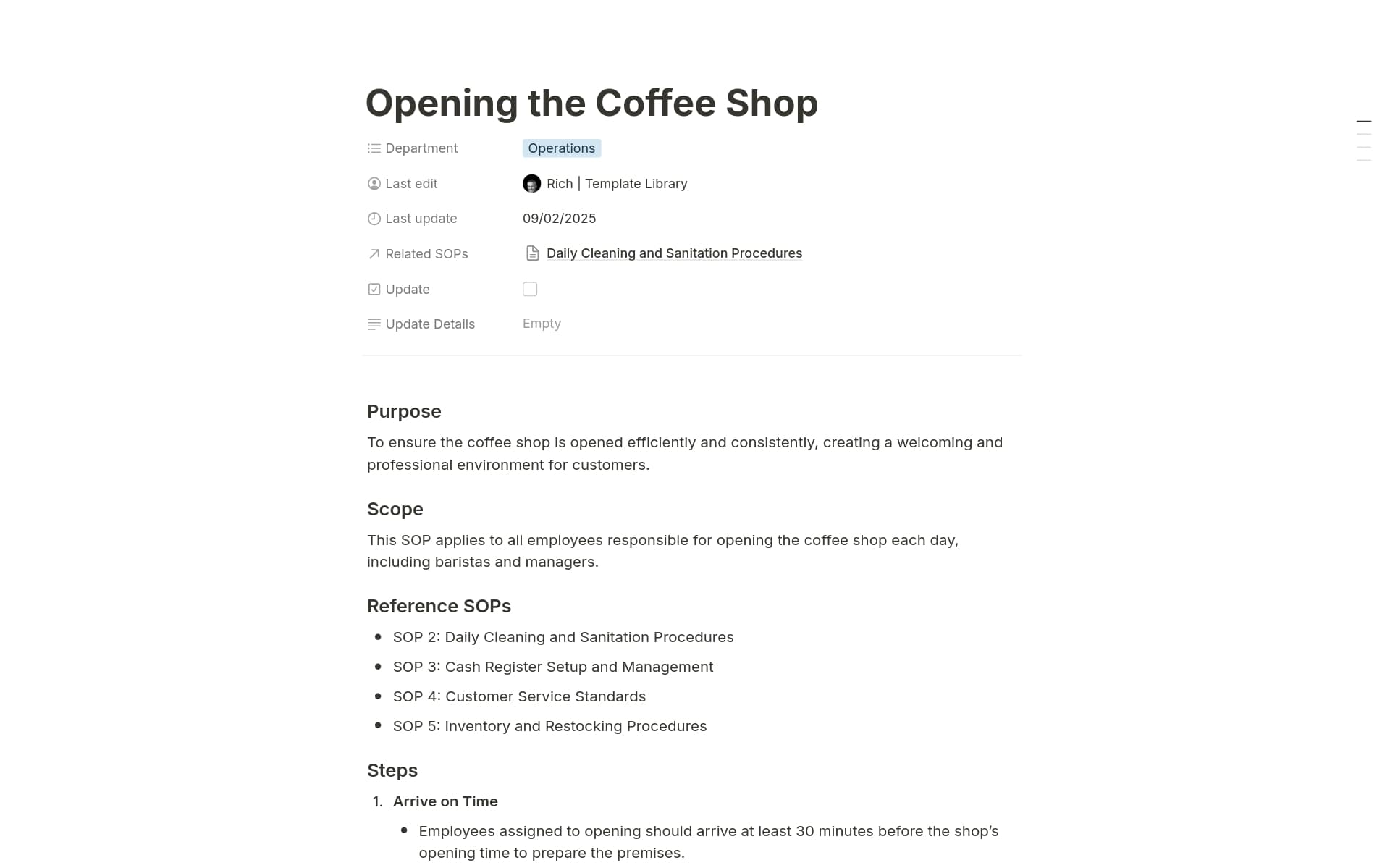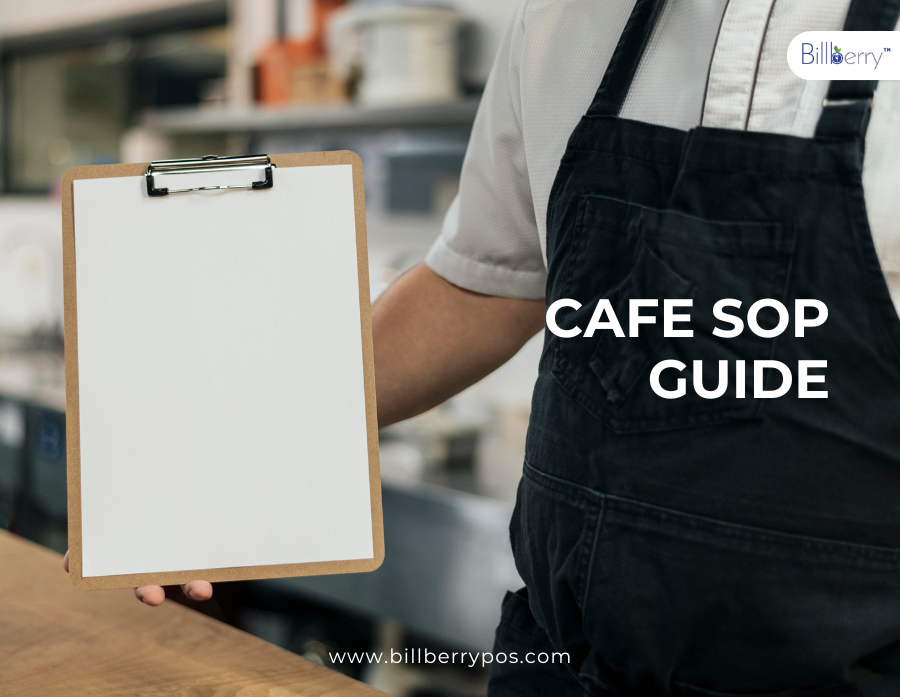Make your cafe run like clockwork. Our Cafe SOP blog walks you through every task your team needs to nail daily service.
Opening a cafe is easy. Running it efficiently every single day? That’s the real challenge. From fluctuating quality and staff confusion to inventory chaos, most cafe owners run into operational headaches. What’s the fix? Well-documented, implemented, and enforced Cafe SOP (Standard Operating Procedures).
In this blog, we’ll break down everything you need to know about Cafe SOPs, including:
~ What they are (and what they’re not)
~ Why your cafe absolutely needs them
~ Step-by-step process to create SOPs for your cafe
~ Sample templates you can use
~ Mistakes to avoid
~ How to digitize and enforce SOPs using a POS like Billberry
What Is a Cafe SOP?
A Standard Operating Procedure (SOP) is a set of clearly defined, repeatable instructions used to perform routine operations. In a cafe, these could include:
~ How to greet a customer
~ How to make an iced latte with exact proportions
~ How to clean espresso machines daily
~ How to check and reorder inventory
~ How to open or close the cafe
Important: SOPs are not employee handbooks or rules, they are step-by-step systems that reduce human error, improve consistency, and ensure a standard quality of operations.
Why Are SOPs Critical in a Cafe Environment?
Let’s understand this with context:
1. Solve the Chaos of Daily Operations
Without SOPs:
~ Each staff member works in their own way
~ Processes break when someone takes leave
~ The owner has to micromanage everything
With SOPs:
~ Staff follow a uniform system
~ Onboarding becomes faster
~ The business can scale even in the owner’s absence
2. Boost Customer Experience Through Consistency
Imagine a customer who loved your cappuccino yesterday, but it tastes different today because a different barista is on duty. Inconsistency is the fastest way to lose loyal customers.
SOPs fix that.
3. Save Time & Improve Staff Efficiency
With SOPs, your team doesn’t ask “What next?” every 5 minutes. They work with clarity and confidence.
4. Control Costs and Reduce Wastage
From managing inventory to reducing spillage, SOPs help prevent small errors that lead to big expenses.
Core SOPs Your Cafe Should Have (With Examples)

Here’s a category-wise breakdown of SOPs you should implement, along with examples.
1. Opening & Closing SOPs
Purpose: Standardize how the day begins and ends, ensuring nothing is forgotten.
Opening SOP Example:
~ Unlock all doors
~ Turn on lights, AC, music
~ Power up POS, kitchen, and coffee machines
~ Check float cash in cash drawer
~ Confirm inventory status of perishables
Closing SOP Example:
~ Turn off all machines
~ Deep clean bar & kitchen area
~ Final cash reconciliation
~ Take backup of sales data (if manual)
~ Lock storage, fridge, cash drawer
2. Customer Service SOPs
Purpose: Ensure all customers are treated well regardless of who is on shift.
SOP Example:
~ Greet customers within 5 seconds of entry
~ Smile and make eye contact
~ Confirm the order and repeat it back
~ Suggest add-ons or combos
~ Thank the customer and invite them again
3. Beverage & Food Preparation SOPs
Purpose: Ensure every item is made to the same standard, every time.
SOP for Classic Cappuccino:
~ Grind 18g of coffee beans fresh
~ Tamp with 30 lbs of pressure
~ Extract espresso for 25–28 seconds
~ Steam milk to 65°C, no visible bubbles
~ Pour to form latte art
~ Serve with a teaspoon and tissue
Include these in your SOPs:
~ Measurements (grams/ml)
~ Temperature guidelines
~ Tools used
~ Plating instructions
4. Inventory & Stock Management SOPs
Purpose: Reduce overstocking, avoid running out of key ingredients, and manage costs.
Inventory SOP Example:
~ Perishables checked daily before opening
~ Non-perishables checked every Sunday
~ FIFO policy (First-In, First-Out)
~ Minimum stock level alerts (e.g., milk below 5L triggers reorder)
~ Wastage log maintained daily
5. Hygiene & Cleaning SOPs
Purpose: Maintain cleanliness standards and comply with food safety regulations.
Daily Cleaning SOP Example:
~ Sanitize all countertops every 2 hours
~ Clean espresso machine heads at shift change
~ Mop floor every 4 hours
~ Wash blender after every use
~ Deep clean fridge every Sunday
6. Staff Management SOPs
Purpose: Ensure a professional, consistent, and fair work environment.
Staff SOPs Example:
~ Staff to clock in/out via biometric/POS
~ Uniform and name badge must be worn
~ Mobile phone use not allowed on floor
~ Break time: max 20 minutes
~ HR escalation process defined
How to Build Cafe SOP from Scratch (Step-by-Step)
~ List All Daily, Weekly & Monthly Tasks
Categorize them: service, kitchen, inventory, staff, cleaning, etc.
~ Observe & Record How Each Task is Done
Film or note how your best staff perform it.
~ Break Each Task into Steps
Use clear, simple language: e.g., “Use 2 scoops of coffee (18g).”
~ Document Responsibilities
Who performs the task, when, how frequently.
~ Test with New Staff
Can someone follow it with no supervision? If not, improve the doc.
~ Create Checklists & Display Them
Print SOPs near workstations. Use laminated checklists where needed.
~ Review Monthly
Business evolves. Update SOPs based on new tools, products, or mistakes.
Sample Cafe SOP Breakdown (Narrative Format)
1. Task: Open Cafe
Steps Involved: Unlock the doors, switch on all lights, power up the coffee machine, and check the cash drawer for float amount.
Frequency: Daily at 8:00 AM
Responsible: Manager
Checklist Location: Kept in the back office near the staff entry point.
2. Task: Prepare Cappuccino
Steps Involved: Grind fresh coffee beans, tamp them properly, brew the espresso shot, steam the milk to the correct temperature, and pour carefully to create latte art.
Frequency: For every cappuccino order
Responsible: Barista on duty
Checklist Location: Posted near the espresso machine at the barista station.
3. Task: Inventory Count
Steps Involved: Check stock levels of milk, sugar, bread, coffee beans, and cups. Update the inventory log. Note any items that need reordering.
Frequency: Every day at 9:00 AM
Responsible: Store assistant or assigned kitchen staff
Checklist Location: Inside the store room, next to the inventory shelf.
4. Task: End-of-Day Report
Steps Involved: Print out the daily sales report from the POS system, verify and count cash, and lock up all drawers and machines.
Frequency: Daily at closing time
Responsible: Supervisor on the closing shift
Checklist Location: On the manager’s desk or office noticeboard.
Common Mistakes When Creating Cafe SOPs
~ Too Complex or Vague – SOPs must be executable by anyone, not just the experienced staff.
~ Lack of Visuals – Add photos or videos where needed (e.g., “How milk foam should look”).
~ No Ownership – Assign each SOP to a role or person.
~ Not Digitized – Paper checklists get lost or ignored.
How to Digitize & Enforce SOPs Using Billberry POS
A POS like Billberry takes SOPs from static documents to living, breathing routines. Here’s how:
~ Role-Based Dashboards: Staff only see tasks relevant to their role.
~ Inventory Alerts: Automatic reorder prompts when stock falls below threshold.
~ Centralized Recipes: Standardized food & beverage prep instructions for all outlets.
~ Daily Reports: From cash summaries to staff activity logs, everything is visible. And many more features…
You don’t just write SOPs. With Billberry, you run them.
Final Thoughts
Running a successful cafe isn’t about passion alone, it’s about process.
Cafe SOPs are your safety net, your playbook, and your passport to scale.
Even the best latte art can’t save a chaotic operation, but a well-run cafe SOP system can create a brand that wins customer loyalty, improves margins, and runs smoothly without constant firefighting.







